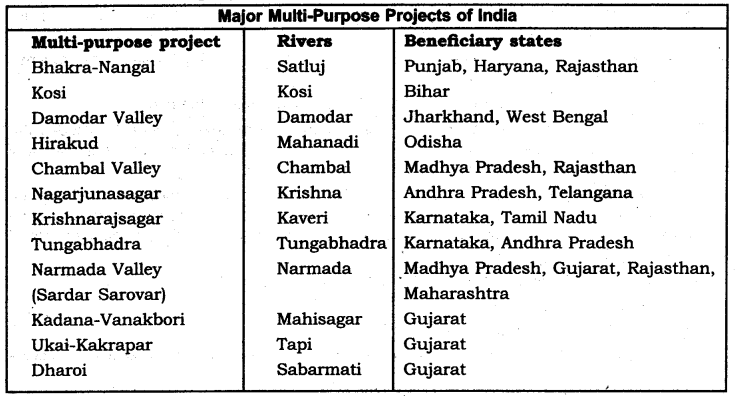Our Revision Notes for GSEB Class 10 Social Science Notes Chapter 11 India: Water Resources summarises the key points of a chapter and useful resource to prepare effectively for the upcoming board exams.
India: Water Resources Class 10 GSEB Notes Social Science Chapter 11
India: Water Resources Class 10 GSEB Notes
→ Water is life.
→ No life can be imagined on the earth without water.
→ Man needs water for drinking, domestic uses and in industries.
→ Water is limited resource. No other resource can be used in its place. Water is an inseparable part of life.
![]()
→ There are three sources of water:
- Rain water
- Surface water
- Ground water.
→ Groundwater is utilized maximum for irrigation.
→ About 84% of water in India is useful for irrigation.
→ Water is being used for irrigation since ancient times.
→ In second century, the famous canal, Grand Anicut, was constructed across the river Kaveri.
→ In 1882, the Eastern Yamuna Canal was constructed in Uttar Pradesh.
→ There are three mediums of irrigation in India i.e.
- Wells and tubewells
- Canals
- Ponds.
→ A multi-purpose project means to solve various problems associated with river valleys. It includes
flood control, prevention of soil erosion, water for drinking and irrigation, industries, water provided to settlements, generation of electricity, internal water transportation, entertainment, wildlife protection and development of fishery etc.
![]()
→ The irrigated area in India has increased four times. Irrigation is practiced in about 38% of net sown area.
→ There is a vast difference between the total area under irrigation with the total area sown.
→ Water crisis refers to water shortage which is constantly intensified due to increasing demand for grains by increasing population, to grow cash crops, increasing urbanization and changing lifestyles of people.
→ The position of water supply and the inequality in the local distribution are challenges to human interests, livelihood and economic development.
→ There is a severe shortage of drinking water in about 8% towns in India.
→ About 2/3 of agricultural region still depend on rain water.
→ The groundwater level has gone down considerably due to more and more water is extracted through wells and tube wells.
![]()
→ The country is facing severe problems because some states extract groundwater in excess volume.
→ Besides agriculture, water is used in industries. Water pollution is basically due to discharged polluted water from domestic uses and industries.
→ The maintenance of water resources is known as water conservation. More construction of reservoirs for water storage, connecting two river basins and bringing the groundwater at higher level.
→ A river basin refers to an area wherein the water of a river, along with the water of its branches forms a watershed.
→ The water during the rainy season flows forward and finally meets the river.
→ The development of a watershed is an overall approach of development. It includes the programmes like soil conservation, water storage, tree plantation, horticulture, development of pasture land, renewal of collective resource.
![]()
→ Rainwater Harvesting: Special methods to collect the rain water and conserve it includes the construction of wells, small dams, khet talavadi (farm ponds), etc. Water is conserved through these mediums. This also raises the groundwater level. This may fulfil the requirements of domestic use and agriculture.
→ Following points should be considered for water management:
- Public awareness is must.
- If possible recycle the used water.
- Increase the use of all units of water harvesting structures like wells, tube wells, khet talavadi etc.
- Keep a close eye on the units those are using groundwater.
- Prevent the deteriotation of water storage units and repair the damaged pipelines immediately to prevent water pollution.
- Local people should be included with their due cooperation for the development and management of water resources. Thus, water should be utilized economically. Various methods are being implemented for water conservation.
→ Water is precious. We need to conserve every drop of water.
India: Water Resources Class 10 GSEB Notes Important Terms
• Source of water: The form of water or its flow is known as source of water.
• Groundwater: The water that is obtained due to the process of water absorbed by the lower strata of the land is known as groundwater.
• Irrigation: The method to provide water to agricultural crop artificially is known as irrigation.
• Water resource: Water is such a resource which is directly associated with the entire living organisms.
![]()
• Multipurpose projects: It is a large scale hydro project often including dams for water retention, canals for irrigation, water processing and pipelines to supply water to cities and power generation. Multipurpose projects are planned on many rivers.
• Water crisis: In the efforts to obtain water by living organisms of biosphere through natural or man made resources, hindrance are created and a problem of water shortage arises. This is called water crisis.
• Water conservation: The maintenance of water resources is known as water conservation.
• Watershed regions: This is a new technique. A river basin is such an area wherein the water of river along with the water of its branches form as a watershed region.
Rain water harvesting: Special method to collect the rain and conserve them.
